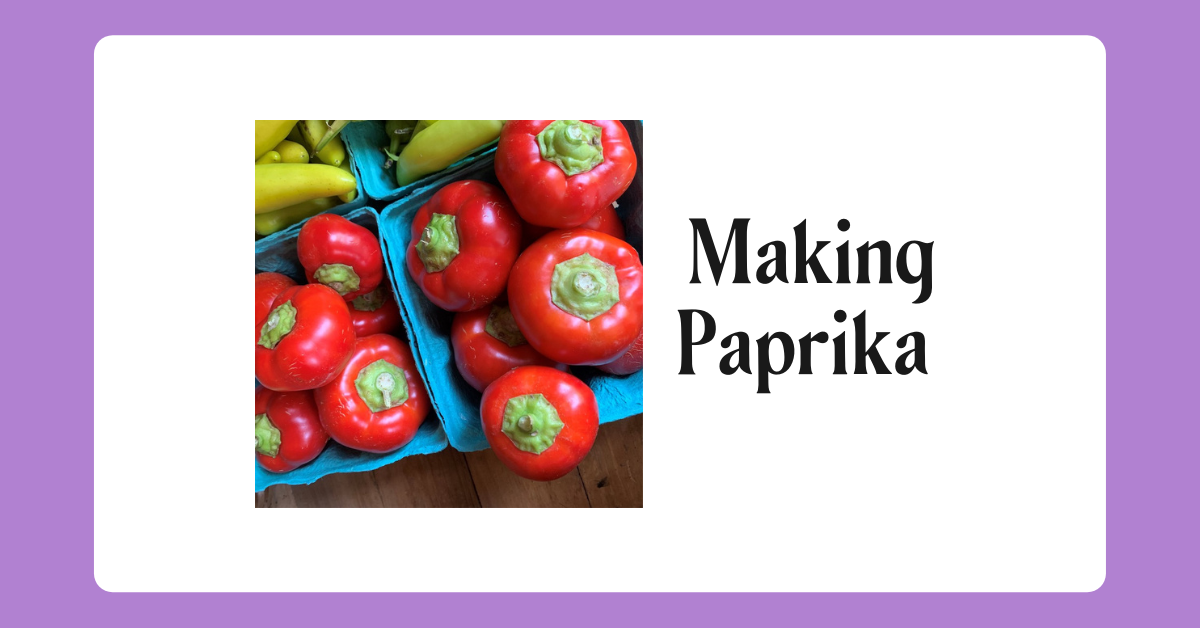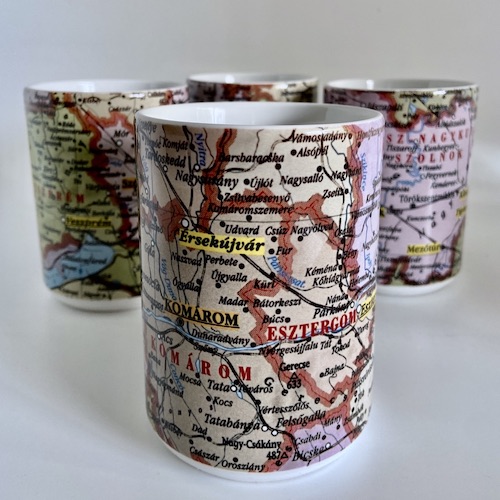I love meeting with people who love connecting with their Hungarian heritage in a variety of ways! Jennifer is one such treasure. Enjoy her adventure with making paprika – I love that it is a farm-to-table experience! ~ Liz
Making Homemade Paprika
Making homemade paprika is a surprisingly easy way to connect to your Hungarian heritage! There is something about creating that beautiful red ground pepper powder that I found to be very rewarding, especially as I went through the whole process from farm to table. My grandparents were all Hungarian immigrant farmers who came to the USA. When they got here, they farmed just like they had in the old country. Now that I live on the family farm, I try to preserve the old ways whenever I can.
No one taught me how to make paprika. My grandma wasn’t making her own paprika anymore when she was cooking her good Hungarian food for me when I was a kid. I’m no expert. I had some trial and error. I’ll be sharing my experiences with you, below.
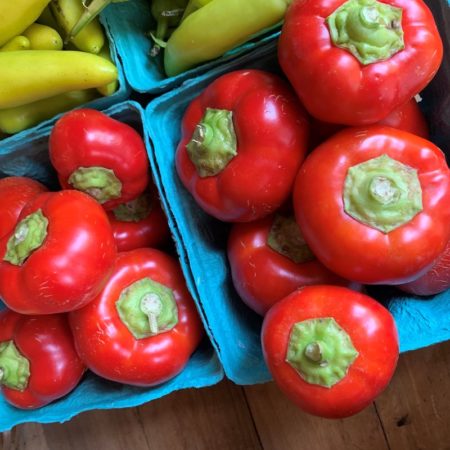 Fresh peppers. There are many types of peppers that can be used to make paprika. The type of pepper that you choose will determine the flavor and the heat of your paprika. Hungarian hot peppers can be used if you like things to be super spicy. For the batch of paprika that I made, I used about 12 alma peppers (also sometimes known as the Hungarian “apple” pepper or “tomato” pepper). The alma comes in both sweet or hot varieties. I used sweet.
Fresh peppers. There are many types of peppers that can be used to make paprika. The type of pepper that you choose will determine the flavor and the heat of your paprika. Hungarian hot peppers can be used if you like things to be super spicy. For the batch of paprika that I made, I used about 12 alma peppers (also sometimes known as the Hungarian “apple” pepper or “tomato” pepper). The alma comes in both sweet or hot varieties. I used sweet.
I think that the alma pepper is a great choice because the flavor is wonderful, and because it is a thick-walled fleshy pepper, which means that you’ll have more substance to grind into paprika.
These peppers may be hard to find locally. It may be best to order seeds online and grow your own. I was lucky enough to have a friend who knew that I was trying to make my own paprika and he grew these beauties among the other peppers out in his field. If you grow your own, you also have the benefit of knowing how they’re raised. I like that my peppers are all natural, organic, and chemical free.
To smoke or not to smoke. Once you have your peppers, you can decide if you want smoked paprika or not. A another article would be needed to explain the details of smoking peppers, so I won’t go into that here. When I made my paprika, I did not smoke them. That’s just because I wanted to get an idea of what these peppers taste like in their pure form.
Once you have your fresh peppers, you also have the option of freezing them to make the paprika later. I got these peppers in late summer when things were very busy on my farm. I froze them for winter, when I tend to spend more time inside the house. You can freeze peppers whole. I just toss them into big Ziploc bags and put them in the freezer. They turn out just fine. I’ve done this with many kinds of peppers.
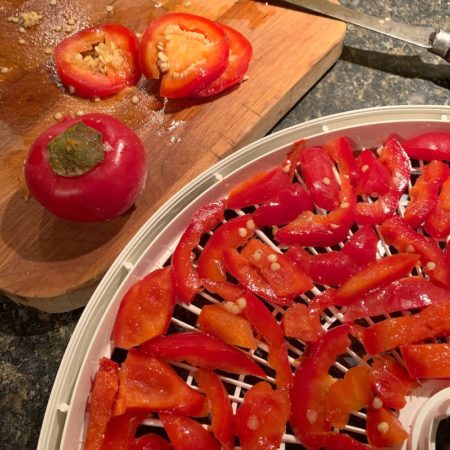 Drying peppers. Once I thawed out my peppers, I cut them into small slices that I could put in my food dehydrator. I removed most of the pepper seeds, focusing on keeping the nice red flesh. I wasn’t being super fussy about it and I did end up with some seeds in there. Seeds will definitely add more heat to your paprika if you leave them. They also don’t grind up as smoothly and you may have tiny seed chunks in your paprika.
Drying peppers. Once I thawed out my peppers, I cut them into small slices that I could put in my food dehydrator. I removed most of the pepper seeds, focusing on keeping the nice red flesh. I wasn’t being super fussy about it and I did end up with some seeds in there. Seeds will definitely add more heat to your paprika if you leave them. They also don’t grind up as smoothly and you may have tiny seed chunks in your paprika.
Drying the peppers is where I failed during paprika projects in the past. You can see the lovely pictures from Szeged, Hungary, where folks in paprika country are hanging up endless bunches of peppers to dry. I could picture the lovely long strands of red peppers hanging gracefully in my Hungarian farmhouse kitchen, waiting to be made into red gold!
Well I had no luck with this. Every time I tried this, my peppers ended up getting moldy. It didn’t matter where I hung the peppers. I even tried to hang them over my dehumidifier. I tried to cut them in half so they could get lots of air. Nope. Still moldy. I was even using the thinner red wax peppers instead of these thick alma peppers. There is a skill to hanging peppers to dry that I am not sure about.
So, this year I sliced the peppers up and I put them in my food dehydrator. This worked great!! Dry them really well, until they are hard. You don’t want them to be squishy at all or they won’t grind well. You may want to put your dehydrator out in the garage or basement while the peppers are drying if you are sensitive to peppers, and especially if you are using hot peppers. The air does get heavily filled with pepperiness while they are drying. Personally, I really like it when my house reeks of peppers. It’s like Hungarian air freshener! But it’s not for everyone!
Dehydrator times can vary greatly, but I dried my peppers for about 2 days.
 Grinding peppers. I’m sure that a mortar and pestle were traditionally used for this part of the paprika process. I am sure that this would still work. But I cheated and I tossed my dried peppers into my food processor, using the “grind” setting. I let it grind until the powder was as fine as I wanted it to be. This is the point where I was staring at my Cuisinart saying, “WOW! I made paprika!!” I was feeling extremely Hungarian!
Grinding peppers. I’m sure that a mortar and pestle were traditionally used for this part of the paprika process. I am sure that this would still work. But I cheated and I tossed my dried peppers into my food processor, using the “grind” setting. I let it grind until the powder was as fine as I wanted it to be. This is the point where I was staring at my Cuisinart saying, “WOW! I made paprika!!” I was feeling extremely Hungarian!
At this point you may be excited about your paprika too. But BE CAREFUL! Don’t open the lid to your food processor right away. Go do something else for a while and let it sit! I made the mistake of opening mine right away and the super fine pepper dust blew into my face, burning my eyes and lips. This didn’t feel great and would have been worse with hot peppers! Let the dust settle. Or open it outside so the breeze blows the fine dust away from you.
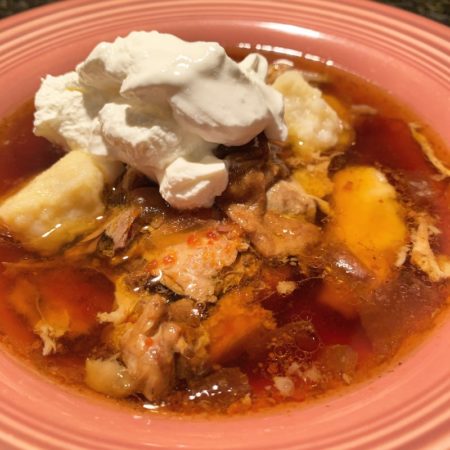 Cooking. Now you have paprika that you can cook with! Of course, I made a batch of chicken paprikas! What better way to really experience paprika? I used a farm-fresh chicken, a little lard from my pigs, onions and paprika from the fields. Cooking with fresh local food is always the best, in my opinion. This is how grandma would have done it!
Cooking. Now you have paprika that you can cook with! Of course, I made a batch of chicken paprikas! What better way to really experience paprika? I used a farm-fresh chicken, a little lard from my pigs, onions and paprika from the fields. Cooking with fresh local food is always the best, in my opinion. This is how grandma would have done it!
I always put LOTS of paprika in my paprikás. I keep adding the spice until it looks like it’s about the same shade of red as my grandma’s paprikas used to look. This usually works (even though mine will never, ever be as good as my grandma’s). However, the fresh paprika is definitely more potent than store-bought paprika, or even the delicious Hungarian paprika that I like to import from Szeged. So, add a little bit of paprika at a time when you are cooking, and use less than what you are used to. Taste as you add. My paprikas turned out quite strong and I think it put some hair on my chest, but it turned out delicious! I really like it! The flavor is wonderful!
